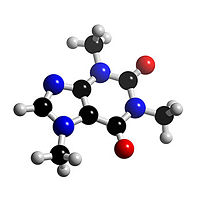It07:Caffeine
Caffeine is best known for its stimulant, or "wake-up," effect. Once a person consumes caffeine, it is readily absorbed by the body and carried around in the bloodstream, where its level peaks about one hour after consumption. Caffeine mildly stimulates the nervous and cardiovascular systems. It affects the brain and results in elevated mood, decreased fatigue, and increased attentiveness. It also increases the heart rate, blood flow, respiratory rate, and metabolic rate for several hours. When taken before bedtime, caffeine can interfere with getting to sleep or staying asleep.
| It07:Caffeine | |
|---|---|
 [1] [1] | |
| General | |
| Systematic name | 1,3,7-trimethyl-1H-purine-2,6(3H,7H)-dione |
| Other names | Caffeine |
| Molecular formula | C8H10N4O2 |
| SMILES | C[n]1cnc2N(C)C(=O)N(C)C(=O)c12 |
| Molar mass | 194.19 gmol-1 |
| Appearance | White Powder |
| CAS number | 58-08-2 |
| Properties | |
| Solubility in water | 15 mg/mL (25°C) |
| Melting point | 234-236.5 °C |
How Caffeine Works
Caffeine causes a change to the balance of chemicals in the brain. It mimics adenosine, and binds to all the adenosine receptors in the brain. The purpose of adenosine is to slow down the nerve impulses and causes drowsiness. With the caffeine blocking the adenosine the brain becomes more alert. This is what leads to the perk of caffeine, keeping you awake at night and waking you up in the morning. Caffeine also increases the levels of dopamine in the brain. This improves your feeling of well-being and improves your mood. It the feel good effect of the dopamine that leads to addiction to caffeine.
Amounts of Caffeine in Everyday Food and Drink
Caffeine is a widely occurring ingredient found naturally in tea, coffee,
cocoa and it is often added to some soft drinks such as Coca Cola and a variety of medicines.
| Drink | Amount of Caffeine (mg/100mls) |
| Coffee (Instant) | 24 |
| Coffee (Filtered) | 61 |
| Coffee (Espresso) | 175 |
| Tea | 20 |
| Coca-Cola | 10 |
| Red Bull | 33 |
| Relentless | 32 |
A lethal amount of caffeine is approximated as 10g. That is 303 cans of Coca-Cola, 167 cups of instant coffee, 121 cans of Red Bull or 114 espresso shots. These amounts are far too much for any human to consume, so there is no real danger of caffeine overdose from a high level of coffee consumption.
Extraction of Caffeine
Pure caffeine is a white powder. Through the years a number of different solvents have been used in removing the caffeine from the coffee beans, to give decaffeinated beans. Benzene, chloroform, trichloroethylene and dichloromethane are some of the chemicals that have been used but due to safety, environmental , cost and flavour issues, they have been replaced by the following methods:
Water Extraction
The coffee beans are soaked in water. The water absorbs the caffeine along with other chemicals in the beans. The water is then passed through activated charcoal, which removes the caffeine. The remaining water is then added back to the beans and evaporated dry. This is because the other chemicals removed from the beans add to the flavour. This leaves decaffeinated coffee beans with minimal loss of flavour.
Supercritical Carbon Dioxide Extraction
Supercritical carbon dioxide is an excellent nonpolar solvent for caffeine. Carbon dioxide is forced through the coffee beans at temperatures above 31.1 °C and pressures above 73 atm. In these conditions carbon dioxide is a supercritical fluid. It has gaslike properties which allow it to penetrate deep into the beans but also liquid-like properties which dissolve 97–99% of the caffeine. The caffeine filled carbon dioxide is then sprayed with high pressure water to remove the caffeine. The caffeine can then be passed through activated charcoal, the same as above, to remove the pure caffeine powder.
Caffeine crystal structure (unit cell)
Caffeine crystal with chloride and water
caffeine |
caffeine |

